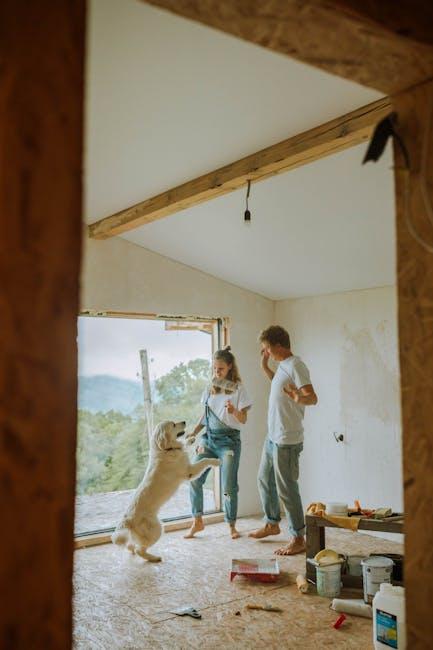Welcoming a pet into your home is an exciting and joyful experience, but it also comes with its own set of challenges—one of the most common being the preservation of your beloved furniture. Whether it’s a curious cat that loves to scratch or a playful pup with a penchant for chewing, teaching your pet to respect your furniture can feel like an uphill battle. However, with patience, understanding, and the right techniques, you can guide your furry friend towards more furniture-friendly habits. In this warm and instructive guide, we’ll explore practical strategies and compassionate approaches to help you create a harmonious home where both your pet and your furniture can coexist peacefully. Let’s embark on this journey together, turning potential chaos into calm and ensuring that your home remains a sanctuary for both humans and pets alike.
Understanding Your Pets Behavior and Needs
Understanding why your furry friend loves to lounge on the couch or scratch the armchair is the first step to creating a harmonious living space. Our pets often use furniture as a playground, scratching post, or a cozy bed, not out of spite, but from natural instincts and needs. Recognizing these behaviors can help you address them with compassion and patience.
- Observe and Identify: Pay close attention to when and why your pet targets the furniture. Is it out of boredom, a need for attention, or simply because it’s their favorite nap spot?
- Provide Alternatives: Offer scratching posts, pet beds, or play areas to fulfill their needs elsewhere. Ensure these alternatives are appealing by placing them near your pet’s usual hangouts.
- Use Positive Reinforcement: Encourage your pet to use these alternatives by rewarding them with treats or affection when they do.
- Set Boundaries: Gently guide your pet away from furniture when caught in the act. Consistent training and clear boundaries will help them understand what’s off-limits.
By addressing your pet’s natural behaviors with empathy and creativity, you can teach them to respect your home while ensuring they feel loved and understood.

Creating a Pet-Friendly Environment at Home
To nurture a harmonious living space where both you and your pet can thrive, it’s essential to establish boundaries with love and patience. Begin by understanding your pet’s natural instincts and providing alternatives to furniture that satisfy their needs. Create designated areas with comfortable pet beds, scratching posts, or interactive toys to divert their attention from your cherished couch or dining table. Remember, it’s not about restricting their freedom, but channeling their curiosity and energy into positive behaviors.
Implementing consistent training techniques is key to fostering respect for your furniture. Positive reinforcement is a gentle and effective method. Praise and reward your pet with treats or affection when they choose their designated spot over your favorite chair. Additionally, consider using deterrents like double-sided tape or pet-safe sprays on furniture to discourage unwanted exploration. By coupling these methods with patience and understanding, you’ll create a serene and pet-friendly atmosphere that respects both your living space and your pet’s well-being.

Positive Reinforcement Techniques for Furniture Respect
Incorporating positive reinforcement techniques is an effective and heartwarming way to guide your pet towards respecting your furniture. Pets thrive on encouragement and affection, and using these elements can turn training sessions into enjoyable bonding experiences. Here are some key strategies to consider:
- Reward Good Behavior: Whenever your pet chooses their designated spot over the couch or resists the urge to scratch, offer them a treat or a gentle pat. Consistently acknowledging these moments helps them associate good behavior with positive outcomes.
- Create a Pet-Friendly Space: Designate a comfortable area with a cozy bed or a favorite blanket. Encourage its use by placing toys or treats there, making it a rewarding alternative to your cherished sofa.
- Use Praise Generously: Pets, like humans, love to be appreciated. A simple “good job” or “well done” in a warm tone can go a long way in reinforcing the desired behavior.
By focusing on positive reinforcement, you not only teach your pet to respect your furniture but also strengthen the loving bond you share.

Establishing Consistent Rules with Love and Patience
When embarking on the journey to teach your pet to respect your furniture, consistency is your best ally. Establishing a set of rules that are followed by everyone in the household helps create a stable environment where your pet knows what to expect. Patience and love are key ingredients in this process, allowing your furry friend to learn at their own pace without fear or anxiety.
- Set clear boundaries: Decide which furniture is off-limits and ensure everyone enforces this rule consistently.
- Use positive reinforcement: Reward your pet with treats or affection when they choose their designated spot over the furniture.
- Be patient: Understand that learning takes time and your pet might not get it right immediately. Offer gentle corrections and encouragement.
By approaching training with a warm heart and steady hand, you’re not just teaching your pet about boundaries; you’re also building trust and a deeper bond. Remember, the goal is not just obedience, but a happy coexistence where both you and your pet can enjoy a harmonious home environment.

